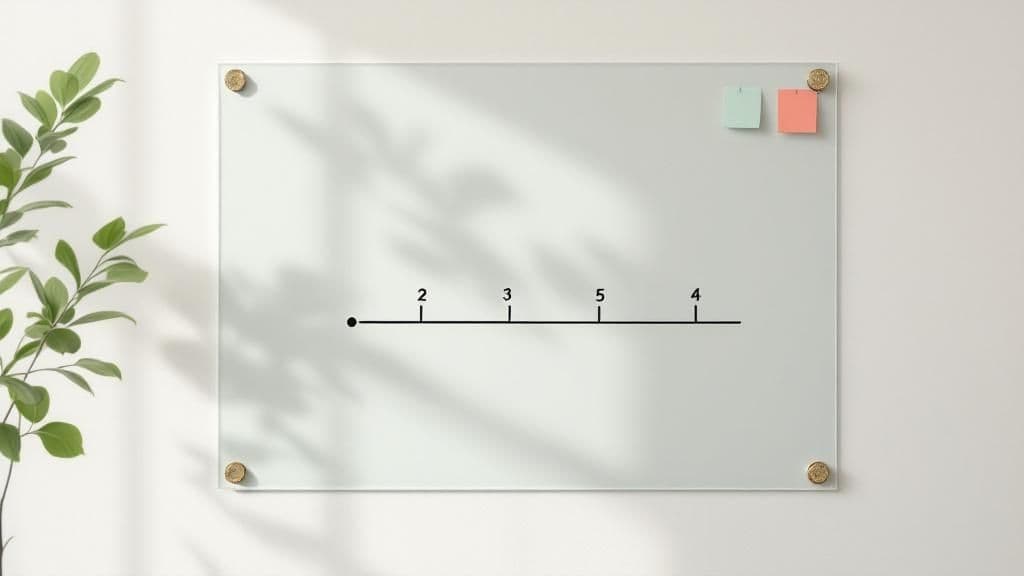Top 7 Client Communication Best Practices for 2025
Discover effective client communication best practices to improve relationships and achieve success in 2025. Click to learn more!

Great work isn't enough; stellar communication is what truly builds lasting client relationships and a thriving business. But let's be real, navigating client conversations can feel like a tightrope walk. One wrong step, and you're dealing with scope creep, missed deadlines, and unhappy stakeholders. The good news? It doesn't have to be this hard. The key is moving beyond generic advice and adopting proven, actionable client communication best practices.
This guide cuts through the noise. We're offering seven concrete strategies that will transform your client interactions from sources of stress into your biggest competitive advantage. You'll learn how to set crystal-clear expectations, listen with genuine intent, and build the kind of trust that turns one-off projects into long-term partnerships. We’ll cover everything from proactive check-ins to managing responses without feeling constantly overwhelmed.
These aren't just abstract ideas; they are practical frameworks you can implement immediately. For an even deeper dive into actionable strategies, consider exploring these expert tips on Client Communication Best Practices to supplement what you learn here. By mastering these skills, you'll not only deliver better project outcomes but also create a more enjoyable and profitable experience for yourself. Let’s get started.
1. Master Active Listening & Empathetic Communication
Let's get one thing straight: hearing isn't the same as listening. Hearing is passive, but active listening is a full-contact sport. It's about fully concentrating on what the client is saying, understanding the intent and emotion behind their words, and responding thoughtfully. This is one of the most crucial client communication best practices because it builds the foundation of trust. Instead of just waiting for your turn to talk, you're stepping into their shoes to grasp their perspective, anxieties, and true goals.

When you practice active listening, you stop solving the problem you think they have and start addressing the one they actually have. This shift from passive hearing to empathetic engagement is what separates a transactional vendor from a trusted partner.
How to Put It Into Practice
Active listening isn't just about nodding along. It requires specific actions to show you're engaged and understanding.
- Practice the 80/20 Rule: Aim to listen 80% of the time and speak only 20%. This forces you to absorb more than you broadcast, giving the client space to fully express themselves.
- Take "Feeling" Notes: During conversations, don't just jot down facts and action items. Note the client's tone. Did they sound excited about one feature but hesitant about another? These emotional cues are gold.
- Paraphrase and Confirm: Regularly use phrases that show you're processing their information. For example: "So, if I'm understanding correctly, the main priority is boosting Q4 sales, but you're concerned about the budget impacting ad creative?" This confirms alignment and makes the client feel heard.
- Send a "Confirm I Heard You" Recap: After a key meeting, send a summary email. Start with something like, "To recap our conversation and ensure I've captured everything correctly..." This demonstrates diligence and provides a clear record of shared understanding. For those looking to refine their professional phrasing, you can learn more about improving your communication skills here.
The legendary customer service of Zappos is a prime example. Their reps are famous for spending hours on the phone with a single customer, not just to solve a shoe problem, but to truly listen and connect on a human level. This empathetic approach is why they built such a fiercely loyal customer base.
2. Proactive Communication and Regular Check-ins
Don't wait for your client to ask, "What's going on?" The best relationships are built on anticipation, not reaction. Proactive communication means you're in the driver's seat, initiating contact, providing regular updates, and sharing relevant information before the client even thinks to check in. This is a cornerstone of effective client communication best practices because it replaces client anxiety with confidence and trust. Instead of leaving them in the dark, you're lighting the path ahead, showing them you're on top of everything.

When you manage the flow of information, you control the narrative. A simple weekly status update can prevent a dozen "just checking in" emails and nervous phone calls. This shift from a reactive to a proactive stance transforms you from a mere service provider into an indispensable strategic partner who consistently demonstrates value.
How to Put It Into Practice
Being proactive doesn't mean bombarding your clients with constant messages. It's about creating a predictable and valuable rhythm of communication.
- Create a Communication Calendar: Just like a content calendar, schedule your check-ins. This could be a weekly "Friday Wins" email, a bi-weekly status call, or a monthly performance review. Consistency is key.
- Automate Status Updates: Use project management tools like Asana, Trello, or Monday.com to send automated updates when tasks move from one stage to the next. This keeps the client informed without adding to your manual workload.
- Send "Value-Add" Content: Don't just communicate about the project. If you read an article relevant to their industry or have an idea that could benefit them, share it. This shows you're thinking about their success beyond the scope of your contract. For more ideas, you can learn more about improving your workplace communication here.
- Always Set Expectations for "Next Time": End every conversation or email by defining the next touchpoint. For example, "Great chat today! I'll send over the draft by EOD Wednesday and we can connect for a quick review on Friday."
HubSpot is a master of this approach. Their automated email sequences don't just sell; they educate and empower users with valuable content, proactively addressing questions and showcasing features. Similarly, a small agency sending a simple, consistent weekly project status email builds the same level of trust, proving that proactive communication is scalable for any business size.
3. Clear Expectations Setting and Boundary Management
Ambiguity is the enemy of a great client relationship. When expectations are fuzzy, scope creep, missed deadlines, and disappointment are practically guaranteed. Setting clear expectations and managing boundaries from day one isn't about being rigid; it's about creating a predictable, professional framework where great work can happen. This is one of the most vital client communication best practices because it prevents misunderstandings before they even start. It turns a potentially chaotic process into a structured partnership.

This practice, championed by figures like Mike Monteiro and the founders of Basecamp, is about defining the rules of the game upfront. You establish explicit, measurable expectations for project scope, timelines, deliverables, and even communication protocols. Beyond just setting boundaries, it's crucial to understand how to effectively manage client expectations throughout the project lifecycle to prevent misunderstandings and ensure project success.
How to Put It Into Practice
Clarity doesn't happen by accident. It requires deliberate documentation and consistent reinforcement to keep everyone aligned.
- Document Everything in Writing: Your motto should be "if it's not written down, it doesn't exist." Use a detailed Statement of Work (SOW) or project brief that outlines every deliverable, timeline, and communication channel. Get it signed before starting.
- Use Visual Timelines: People process visual information faster. Use tools like Gantt charts or simple visual roadmaps to show key milestones and deadlines. This makes the project plan tangible and easy for clients to understand at a glance.
- Create Communication Boundaries: Clearly state your working hours and preferred communication methods. For example: "Our team is available from 9 AM to 5 PM, and we respond to non-urgent emails within 24 hours. For emergencies, please call this number."
- Build in Buffer Time: Projects rarely go exactly as planned. Add a 15-20% buffer to all your time and budget estimates to account for unexpected revisions, delays, or challenges. This protects your profitability and manages client stress.
A fantastic example is how top consulting firms like McKinsey operate. They use highly structured statement of work documents that leave no room for interpretation, defining everything from the project's core questions to the exact format of the final report. This level of upfront clarity is why they can manage massive, complex projects with precision.
4. Transparent and Honest Communication
Transparency isn't just about telling the truth; it's about proactively sharing the whole picture, good and bad, before you're asked. It means being open about your processes, admitting to mistakes the moment they happen, and providing honest assessments of your capabilities. This approach to client communication best practices moves you from a service provider to a genuine partner, building a level of trust that can withstand even the toughest challenges.

When you hide a problem, you’re not just delaying the bad news; you're creating a second, bigger problem: a breach of trust. Being upfront, even when it’s uncomfortable, shows respect for your client and confidence in your ability to navigate issues together. As Brené Brown's work on vulnerability highlights, this authenticity is what truly forges strong, resilient relationships.
How to Put It Into Practice
Building a culture of transparency requires intentional effort and a commitment to openness in every interaction.
- Deliver Bad News Quickly: The longer you wait, the worse it gets. Address issues head-on, preferably in a call or in person. Follow up with a clear email that outlines the problem, its impact, and your proposed solution. Honesty in these moments is critical, and for those tough emails, you can discover more by reviewing professional email writing tips.
- Couple Problems with Solutions: Never present a problem without also presenting a solution, or at least a plan to find one. This shows you’re not just passing the buck; you're taking ownership. For example: "We've hit a technical snag that will delay the launch by 48 hours. To mitigate this, we have already reallocated a developer to fix the issue and plan to work through the weekend."
- Be Honest About Your Limits: If a client asks for something outside your expertise, don't pretend you can do it. The most powerful response is an honest one: "That particular task is outside our core skill set. However, I know a specialist who is fantastic at this, and I'd be happy to connect you." This builds more trust than faking it ever will.
- Reward Honesty Internally: Create a team environment where bringing problems to light is rewarded, not punished. When your team feels safe to be transparent with you, they'll be transparent with clients.
A great example is the software company Buffer, which famously made its revenue, salaries, and equity formula public. This radical transparency built immense trust not just with their team but with their entire user base, proving that openness can be a powerful business advantage.
5. Implement a Smart Multi-Channel Communication Strategy
In today's hyper-connected world, your clients aren't just in one place, so your communication shouldn't be either. Sticking to email when your client lives in Slack is like sending a letter when they're waiting for a text. A multi-channel communication strategy is about meeting clients on their preferred platforms, whether that's email, a dedicated Slack channel, a project management tool, or even WhatsApp for quick updates. This approach is one of the most impactful client communication best practices because it removes friction and makes it incredibly easy for clients to engage with you.
By creating a deliberate strategy instead of a chaotic free-for-all, you ensure messaging is consistent and professional across all touchpoints. You're not just being available everywhere; you're being strategically present where it matters most to each client, adapting to their unique workflow and communication style. This flexibility shows respect for their time and preferences, turning communication from a chore into a seamless part of the collaboration.
How to Put It Into Practice
Building an effective multi-channel system requires clear guidelines, not just more accounts on different platforms.
- Set Clear Channel Protocols: Don't leave it to guesswork. Define the purpose of each channel. For example: Use Slack for quick, real-time project collaboration; Asana or Trello for formal task assignments and progress tracking; and email for official approvals, contracts, and meeting recaps.
- Survey Your Clients Upfront: During your onboarding process, simply ask, "What's the best way to communicate with you for day-to-day updates versus formal sign-offs?" This small gesture shows you value their process and sets the stage for smooth communication from day one.
- Use a Centralized Hub: To avoid losing track of conversations, leverage tools that integrate multiple channels. A CRM like HubSpot or a customer service platform like Zendesk can pull communications from various sources into a single client view, giving you a complete history at a glance.
- Train Your Team: Ensure everyone on your team understands the "rules of engagement" for each channel. This prevents inconsistent messaging and ensures a client gets the same professional experience regardless of who they talk to or where the conversation happens.
6. Adopt a Personalized Communication Approach
Treating every client the same is a one-way ticket to mediocrity. A one-size-fits-all communication strategy ignores the simple fact that clients are individuals with unique personalities, preferences, and business needs. Adopting a personalized communication approach means you tailor your style, frequency, and even the medium you use to fit each specific client. This is a game-changing client communication best practice because it shows you see them as more than just an invoice.
When you align your communication with their world, you’re not just sending an update; you’re building a relationship. This deliberate customization makes interactions more meaningful, reduces friction, and transforms you from a service provider into an indispensable partner who just gets them.
How to Put It Into Practice
Personalization goes beyond just using their first name in an email. It’s about adapting your entire communication framework to the person you're speaking with.
- Create Detailed Client Profiles: Go beyond project details. Document their communication preferences in your CRM or project management tool. Do they prefer quick Slack messages or formal emails? Are they a "big picture" person or do they need every little detail?
- Adapt to Their Style: Pay attention to their cues. If a client is always direct and data-driven, give them bullet points and metrics. If another is more relational and chatty, start your calls with a bit of small talk. Mirroring their style builds rapport almost instantly.
- Ask Directly for Feedback: Don't be afraid to ask, "Is this level of communication working for you?" or "Would you prefer a weekly summary email instead of daily updates?" This proactive question shows you respect their time and workflow.
- Segment Your Communications: Not every message is for every client. If you have a newsletter or send out industry updates, segment your list based on client industry, service type, or interest level. This ensures they only receive information that is genuinely valuable to them.
Think about how a great financial advisor works. They don't give the same advice to a risk-averse retiree and a young, aggressive investor. They tailor their entire communication strategy, from the language they use to the frequency of check-ins, based on the client's individual personality and goals. This level of personalization is what builds unshakable trust.
7. Timely and Consistent Response Management
In the age of instant gratification, a slow response is often perceived as a non-response. Timely and consistent response management isn't just about being fast; it's about being reliable and setting clear expectations. It's a systematic approach that ensures your client never feels like their message has been tossed into a digital black hole. This is one of the most impactful client communication best practices because it directly influences client perception of your professionalism and respect for their time.
A swift, predictable response system builds immense trust. It tells the client that you are organized, attentive, and in control of your workflow, which gives them confidence in your ability to handle their project. This proactive communication prevents anxiety and reduces the need for them to send "just checking in" emails, freeing up both of you to focus on the actual work.
How to Put It Into Practice
Building a reputation for responsiveness requires a clear system, not just good intentions. Here are concrete ways to manage client expectations and deliver on them every time.
- Set Clear Response SLAs: Define and communicate your Service Level Agreements (SLAs) for responses. For instance, "We respond to all emails within 24 business hours." State this in your kickoff call and include it in your welcome packet. This simple act prevents misunderstandings from the start.
- Use Acknowledgment Auto-Responders: For your primary contact email, set up a simple auto-responder. It should acknowledge receipt and reiterate your response time. A message like, "Thanks for your email! We've received it and will get back to you within one business day," works wonders for client peace of mind.
- Create Template Responses: Identify your most common inquiries and create pre-written templates. This doesn't mean sending robotic replies, but rather having a solid, approved starting point that you can quickly personalize. This drastically cuts down response times for routine questions.
- Implement a "Feedback Loop" Process: When a client provides feedback or reports an issue, don't just fix it and move on. Acknowledge their input, provide updates on your progress, and confirm once the issue is resolved. A vital aspect of consistent response management is effectively closing the feedback loop with your clients, demonstrating that their input is valued and acted upon.
A classic example is the ITIL framework used in IT service management. When a support ticket is created, the user immediately gets a confirmation with a ticket number and expected response time. This systematic approach, also seen in the responsive customer service cultures at companies like Southwest Airlines, is what separates reliable partners from unpredictable freelancers.
7 Best Practices Comparison Guide
| Communication Approach | Implementation Complexity 🔄 | Resource Requirements ⚡ | Expected Outcomes 📊 | Ideal Use Cases 💡 | Key Advantages ⭐ |
|---|---|---|---|---|---|
| Active Listening and Empathetic Communication | Medium to High - ongoing training needed | High - time-intensive and emotionally taxing | Builds trust, uncovers hidden needs, effective problem-solving | Complex client issues requiring deep understanding | Builds rapport, reduces conflicts, increases loyalty |
| Proactive Communication and Regular Check-ins | Medium - requires planning and automation | High - scheduling, tools, multi-channel management | Prevents issues, increases retention, strengthens relationships | Long-term projects, client retention, upselling opportunities | Demonstrates professionalism, prevents escalations |
| Clear Expectations Setting and Boundary Management | Medium - upfront time investment | Medium - documentation and monitoring | Reduces scope creep, minimizes disputes, improves success rates | Projects with defined scopes, legal or consulting engagements | Protects relationships, enables better resource planning |
| Transparent and Honest Communication | Medium - needs communication skill development | Medium - cultural and skill investment | Builds trust, reduces anxiety, enables collaboration | High-stakes projects, sensitive client relationships | Builds credibility, prevents larger issues |
| Multi-Channel Communication Strategy | High - managing multiple platforms and protocols | High - multiple tools, integrations required | Increases accessibility and responsiveness | Diverse client bases with varied preferences | Accommodates preferences, reduces communication barriers |
| Personalized Communication Approach | High - requires detailed knowledge and customization | High - time and resource intensive | Improves engagement, strengthens relationships | High-value clients, complex needs, B2B relationships | Increases satisfaction, reduces misunderstandings |
| Timely and Consistent Response Management | Medium - requires defined processes and tracking | Medium to High - staffing and automation | Builds confidence, prevents issue escalation | Customer support, regulated industries | Builds trust, improves satisfaction, demonstrates reliability |
Turn Great Communication into Your Greatest Asset
We've explored a powerful lineup of client communication best practices, moving from the foundational skill of active listening to the strategic necessity of managing response times. At first glance, it might seem like a lot to juggle. But these aren't just isolated tips; they are interconnected components of a single, powerful system for building unbreakable client relationships.
Think of it like building a house. Setting clear expectations is your foundation. Proactive check-ins and transparent updates are the sturdy framework. Empathetic and personalized messages are the interior design that makes clients feel at home. Each element supports the others, creating a structure of trust that can withstand misunderstandings, scope creep, and unexpected challenges. Mastering this system doesn't just prevent problems; it actively creates opportunities, turning satisfied clients into your most enthusiastic advocates.
From Theory to Daily Practice
The real challenge isn't understanding these concepts, it's implementing them consistently, especially when you're busy. The gap between knowing what to do and actually doing it is where most relationships falter. The key is to transform these best practices from an abstract checklist into ingrained habits.
Start small and build momentum. Here are a few actionable next steps you can take this week:
- Conduct a Communication Audit: Review your last five client email chains. Where could you have been more proactive? Was there an opportunity to show more empathy? Identify one specific area for improvement.
- Create Your "Boundaries" Template: Draft a standard but polite response for when a request is out of scope or will require a timeline adjustment. Having this ready removes the friction of writing it from scratch under pressure.
- Schedule Proactive Check-ins: Go into your calendar right now and schedule a brief, 15-minute check-in call or a reminder to send a "just checking in" email to your key clients for next week.
The Ultimate Goal: Communication as a Competitive Advantage
Ultimately, these client communication best practices are about more than just keeping people happy. They are about building a reputation for reliability, professionalism, and genuine care. In a crowded market, your technical skills or creative talent can get you in the door, but it's the quality of your communication that will keep you there and generate referrals.
When clients know they can count on you to listen, understand their needs, and keep them informed, you are no longer just a service provider. You become an indispensable partner in their success. This transformation from a vendor to a partner is the most valuable asset you can build. It's what allows you to charge premium rates, retain clients for the long term, and build a business that is not only profitable but also deeply rewarding.
Ready to make exceptional communication your superpower without sacrificing speed? TypeBoost integrates directly into your workflow, allowing you to instantly refine your tone, summarize complex updates, and apply your best communication strategies with a simple keyboard shortcut. Start building better client relationships faster by downloading TypeBoost today.